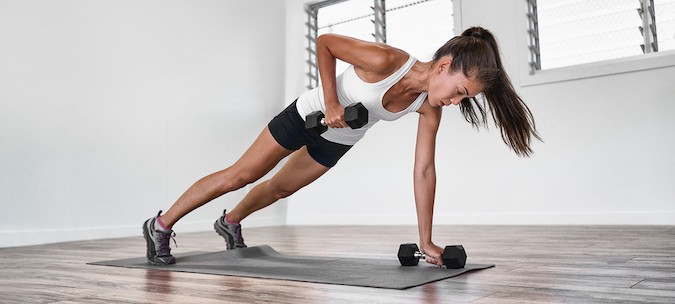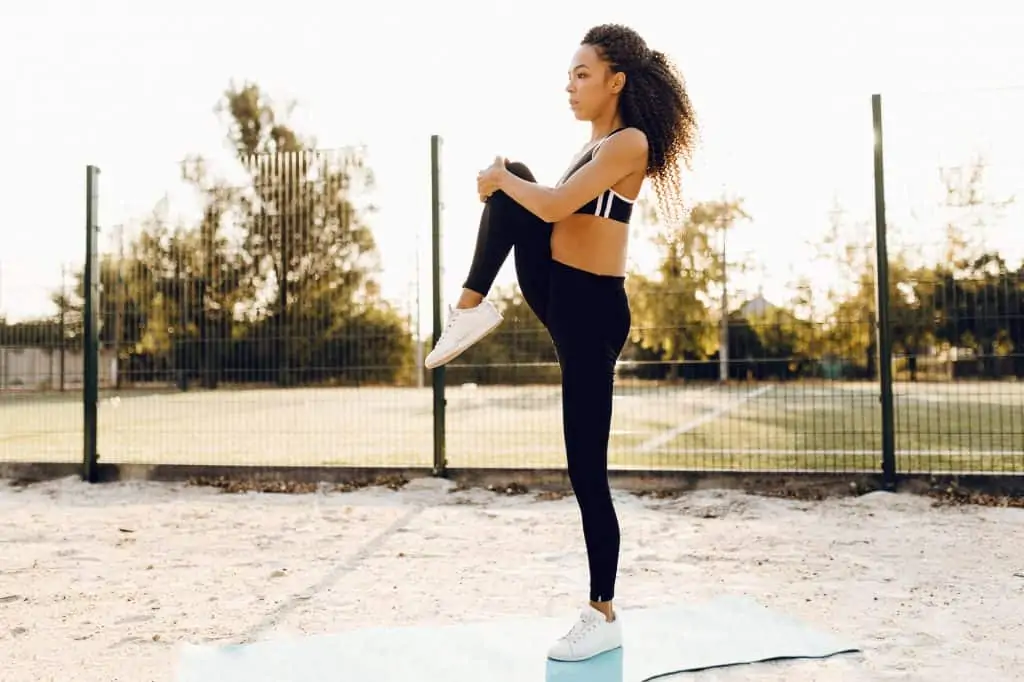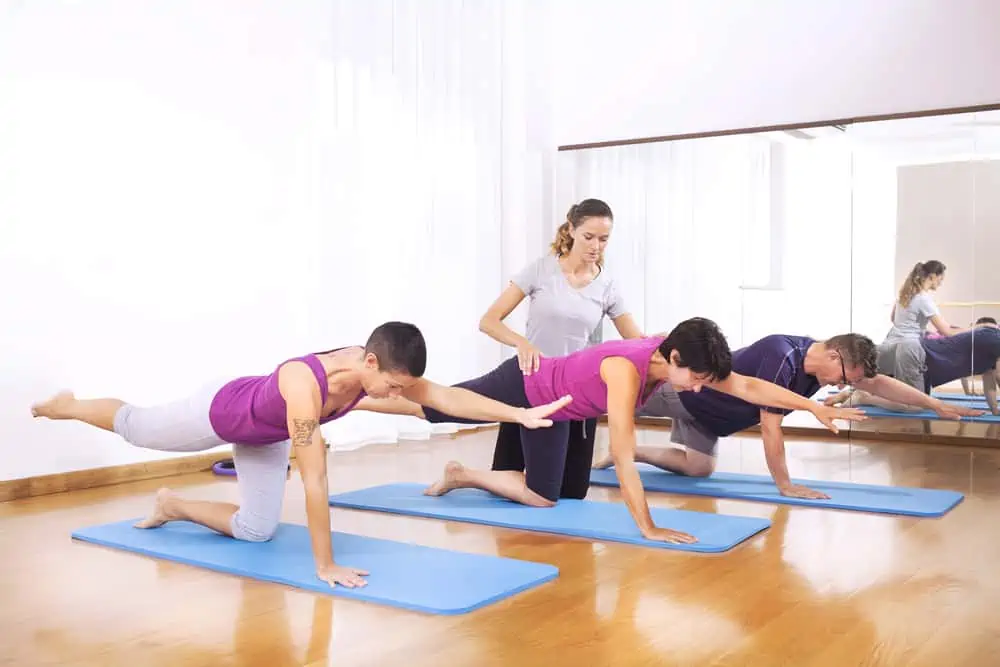This post may contain affiliate links. If you click through a link and make a purchase, I may receive a commission at no additional cost to you. As an Amazon Associate, I earn from qualifying purchases. Read the full disclosure here.
Everyone is on the pursuit of that elusive magical fitness hack. That quick fix. That one thing that will transform their lives and then (insert skewed vision of outcome here)!
Bad news.
When it comes to overall health benefits, there is no magical time-saving hack that will produce the same results as a consistent well-rounded fitness program.
So what’s the secret?
It’s simple, let me show you how to build a well-rounded fitness program that gives back to you!
Disclaimer: This content is for educational purposes and is not medical advice. Read the full disclaimer.
What does a well-rounded fitness routine mean?
The short answer means having components of cardio, strength training, flexibility, and balance sprinkled in throughout the week.
It’s been well documented time and time again that exercise is the best prevention in the fight against disease and chronic illness.
I’ll say that a little louder for the people in the back.
The fad fitness and diet world focuses largely on aesthetics, quick fixes, and extremes. Regular exercise boasts a long list of health benefits that extend way beyond fitting into your jeans.
But don’t take my word for it, do a little research yourself.
Health benefits of exercise
Referenced from the Physical Activity Guidelines for Americans, 2nd edition.
- Lower risk of all-cause mortality
- Lower risk of cardiovascular disease mortality
- Lower risk of cardiovascular disease (including heart attack and stroke)
- Lower risk of hypertension
- Lower risk of type 2 diabetes
- Lower risk of unhealthy lipid profile
- Lower risk of certain cancers
- Improved cognition
- Reduced risk of dementia
- Improved overall quality of life
- Reduced anxiety and depression
- Improved sleep
- Weight loss
- Prevention of weight gain
- Improved bone health
- Improved overall physical function
- Lower risk of falls and fall related injuries in older adults
With all those potential health benefits, how can you afford NOT to?!
How much exercise do you really need?
How much physical activity do you need to get substantial health benefits from exercise?
- At least 150 min of moderate-intensity exercise or 75 min of vigorous-intensity activity per week
- Strengthening exercises for all major muscle groups at least 2 days per week
- Additional health benefits are gained when increasing aerobic activity to 300+ minutes per week
Related Read: How To Be More Active When You Hate Exercise
How to build a fitness plan
Why are all of these puzzle pieces necessary?
Can’t I just do Y
Well, no. And here’s why.
Each component of your exercise routine offers specific health benefits.
If you only do Yoga or only run or only lift weights, you’re missing out on some key benefits. Benefits that not only can boost your overall health in the long run but make you better at that one thing that’s your favorite.
Let’s take a closer look at each so you can build a fitness plan in a way to give back to you in the long term.

Cardiovascular exercise (aerobic exercise)
What does cardio exercise mean?
Loosely put, a cardio workout is any activity that raises your heart rate. This is also considered aerobic activity.
Don’t worry, no colorful leotards required.
The new Physical Activity Guidelines for Americans recommends at least 150 min total per week of moderate-intensity cardio or 75 min total of vigorous aerobic activity for significant health benefits.
Intensity is often measured in target heart rate ranges.
Target heart rate ranges will vary by age and medical status. Make sure you visit a qualified practitioner to help you determine your target range.
That may sound like a daunting amount of cardio. And it may be a goal to work toward.
It depends on your current activity level.
Health benefits of cardio exercise
Cardio isn’t called cardio just for the heck of it. Aerobic fitness has benefits for the heart, lungs, cirulation, endurance, and mood.
- Improved cardiorespiratory fitness and endurance
- Improved circulation including oxygen delivery to tissues and removal of waste
- Cardio exercise helps maintain a healthy weight
- Decreased risk for cardiac and other health issues

Examples of cardio workouts
Lots of activities can provide cardiovascular benefits. It’s all about getting your heart rate up to a moderate intensity for a period of time.
- Walking
- Running
- Swimming
- Aerobics
- Spinning
- Biking
- HIIT and interval training
- Dance party
- Compound weight lifting movements (that work the whole body)
Again, what gets your heart rate gets up to depends on your overall fitness level.
And no, most yoga classes don’t count as cardio. (But have other great benefits!) While there may be periods of elevated heart rate, it’s likely not sustained in your target heart rate range to meet true cardio criteria.
Related read: 18 Low Impact Workout Options To Keep You Moving
Strength training exercise
What does strength exercise mean?
Strengthening means producing a muscle contraction against resistance (weights, bodyweight, resistance band) and working against a force to improve overall strength and function.
Strength training can mean different things to different people, and that’s ok. Don’t be intimidated by the phrase.
Health benefits of strength training
There is some overlap with cardio. However, strength training brings some additional benefits to the table.
- Improved strength, muscle mass, and function
- Improved bone strength
- Decreased risk for osteoporosis
- Strength training helps maintain a healthy weight and decrease the overall risk for health issues
According to research, loss of muscle mass can start as early as 30 (yikes!) and continue to decrease each decade, therefore strength training is an essential piece of a well-rounded fitness program.

Does lifting weights make you bulky?
Listen up ladies! One of the biggest myths out there is women will “get bulky” if they lift weights.
Science wins.
Women don’t have the same ratio of hormones as men, and as a result, don’t build muscle mass at the same rate. Feel free to keep researching this, the myth is still going strong.
Progressing appropriately to heavier weights (if this is
Heavy weights can mean different things to different people. It depends on the individual and the movement.
This does not mean go out and start lifting heavy weights without proper form, adequate strength, and instruction.
The take-away here is not to purposefully limit yourself from progressing smartly based on an old myth.
If you’re new to weight training, it’s in your best interest to do some research and maybe even work with a personal trainer on the types of equipment you’re going to use to avoid injury.
And please, don’t just watch someone in the gym and copy them! There are many people out there using equipment improperly.
Examples of strength workouts
Strengthening means working against some type of resistance. This can mean different things to different people, what your goals are, and what equipment you have access to.
Resistance can come from bands, bodyweight exercises such as push-ups, squats, lunges, free weights, weight machines, etc.
Pilates can also be strengthening due to a focus on postural and core muscles.
Mobility & flexibility
Mobility exercises are having a moment right now, but they’re not a new concept. Mobility refers to how well you can move and is the result of flexibility, range of motion, and strength just to name a few.
Flexibility refers to available range of motion (ROM) and soft tissue extensibility and how restricted you feel moving through different ROMs.
Flexibility is determined by joints, muscles, tendons, ligaments, fascia, and the overall tone of the nervous system.
If you can move well with less effort, there is less risk of injuries and long term wear and tear.
Read: Mobility vs Stability vs Flexibility – How to Unlock Healthy Movement

Health benefits of flexibility exercise
- Improved mobility
- Improved posture
- Improved functional ROM
- Decreased risk for injury
- Improve your ability to perform cardio and strength training movements
How to improve flexibility
There are many different ways to improve flexibility. The best results come from a combination of active and passive techniques.
Some ways to incorporate more flexibility into your fitness routine are:
- Yoga
- Static stretching
- Dynamic mobility exercises
- Foam rolling combined with stretching
- Proprioceptive Neuromuscular Facilitation (PNF stretching techniques)
Stretching and flexibility seem so easy, yet many get it wrong, resulting in injuries or wasted time.
Read How To Stretch Properly & Avoid Injury for all the insider tips on how you can stretch the right way.
Balance training
Un-scientifically put, balance is your ability to stay upright on your own two feet when moving through life.
Every time I trip over something and land like a graceful cat, I’m thankful I work on my balance and got out of that one unscathed. Whew!
Guess what? It’s another skill that falls under “if you don’t use it you lose it.”
Balance exercise improves your proprioception, which is your ability to know where a limb is in space.

Health benefits of balance exercises
- Improved reaction time, agility, and athletic performance
- Improve sense of proprioception and movement awareness
- Decreased risk for falls/injury from falls
When you work on balance, your reaction time and ability to quickly adjust to changes in surface or equilibrium improve. This means less chance of injury, no matter what your fitness level.
Balance also deteriorates with age. It’s an important skill that’s easier to maintain than wait until its a problem.
Working on balance can mean the difference between a close call and a life-changing injury cascading into a downward spiral of loss of function and quality of life.
That might sound dramatic, but I’m sure you know a mom or grandma that was going along just fine and then had a fall. And it was all downhill from there.
Don’t neglect balance.
How to improve balance
The level of balance training appropriate for you will vary by fitness level just like everything else.
It can be as simple as how long you can stand on one foot, or more challenging like standing on a balance pad or BOSU ball. It depends on how coordinated you are and what’s appropriate for your level.
You may have noticed some of those yoga poses like the warriors, tree, or half-moon are very challenging to your balance.
Many also turn to Tai Chi to help with balance.
Putting it all together
Fitness routines can look very different between two people, and both be considered well-rounded.
You may have noticed many of the categories have overlapping benefits but also include benefits specific to that category.
All that said, the most effective workouts are the ones you will actually do. So if your schedule only allows for 2x per week of yoga, stick to attainable goals.
Don’t set yourself up to fail. Try to incorporate each element into your schedule where you can. It’s not as hard as you may think!
Maximize the time you do have. Take a look and your fitness routine and see where you can make some positive changes.
Make sure your fitness routine has the pieces you need to reach your goals. And seek out the appropriate professionals to help you stay injury-free along the way.
Featured image credit: Copyright Pixelrockstar







I’m glad to hear that regular, purposeful exercise, NOT the fads, can give us so many health benefits. I hadn’t heard of HIIT before, so you’ve given me something to look into. Thank you for the information and inspiration.
Incredibly informative post! I learned a lot about things I may be neglecting in my own routine. Thanks for sharing!
Such great tips! Thanks for posting 🙂
A well-rounded fitness routine really is a must for a healthy life. I’m glad that you mentioned balance in relation to fitness. I often see people doing way too much cardio and neglecting strength training and flexibility or doing the opposite and not including cardio.
Absolutely, we all have those things we love to do, but so important to vary activity. Thanks for reading.
I’m a triathlete and every single one of the things you have mentioned come into play in my own training. Thank you for covering what I consider to be everything that keeps me well balanced as an athlete!
Thank you, lots of luck with your training.
Fitness advice is just as polarizing as nutrition advice. There is so much information out there that is contradictory, confusing and overwhelming.
You perfectly explained individuality and how to make an exercise program work for you. The same goes for nutrition. Not every diet will work for every person.
Of course, one of the most important things about fitness is finding a way to ENJOY it. That’s not always easy! I’m still working on it 🙂
Thank you so much. You’re correct about fitness and nutrition being polarizing. It’s important to understand the basics to build what works for you. Thanks for reading!
I was diagnosed with a severe anxiety disorder and after trying almost every medication under the sun, I discovered that exercise was truly the only way to go. I’m now off all of those harmful meds and feel better than ever! Exercise is so important!
awesome post I love weightlifting but the last few workout programs I been doing is all bodyweight so far.
I’m about to start my fitness journey and this post was super helpful with understanding fitness better! Thanks for sharing (:
Erika Marie | https://imerikamarie.com
I’m about to start a fitness routine for myself. This info is great! Thanks for sharing!
I love that you stress the importance of a balanced workout routine. I’ve had a relatively lazy summer (the odd hike or bike ride here and there), but it’s time for me to get back into a more regular routine. I’ve started by getting back into yoga, and once (if? lol) I get a habit built, I want to expand into the other areas you mentioned. I just need to get some momentum going!
I used to have a pretty regular workout routine of weights, Crossfit and Krav Maga training but completely fell out of it a few months ago (thanks to a back injury and our baby arriving). Now that the baby is starting to develop a routine/schedule, I am really hoping to get back into my own routine. I think I have put on more weight during the pregnancy than my wife did…
Love your writing style Maura! A ton of great information, sprinkled with lots of facts and sound/practical advise.
Thank you for reading!
Hi!
This was such a great post with a great deal of information. I’m definitely going to start incorporating different types of exercise.